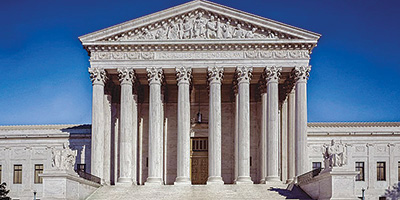Anti-worker Supreme Court majority begins troubled term
Key case could be a threat to democracy
 Washington (PAI) – With its credibility on a one-way dive downwards with the public – and with at least one justice – the U.S. Supreme Court embarked on a new term on Oct. 3 preparing to hear at least four cases which, if the right-wing and anti-worker majority continues to vote in ideological lockstep, could only make matters worse.
Washington (PAI) – With its credibility on a one-way dive downwards with the public – and with at least one justice – the U.S. Supreme Court embarked on a new term on Oct. 3 preparing to hear at least four cases which, if the right-wing and anti-worker majority continues to vote in ideological lockstep, could only make matters worse.
Indeed, progressive and non-partisan groups are already sounding the alarm that if the justices rule for the right-wingers who brought it, Moore v Harper could endanger democracy itself.
The court’s Republican-named majority has been hostile to workers’ rights, too – so much so that AFL-CIO General Counsel Craig Becker told a presidential commission last year that workers’ lawyers go into any hearing automatically assuming they’re going to lose.
Just over a year ago, in a speech at an institute named for Senate Republican leader Mitch McConnell, Republican-named Justice Amy Coney Barrett declared “this court is not comprised of a bunch of partisan hacks.” Unions reply that rulings on their cases show it is.
THE THREAT TO DEMOCRACY
In Moore v. Harper, the Supreme Court will decide whether the North Carolina Supreme Court has the power to strike down the legislature’s illegally gerrymandered congressional map for violating the North Carolina Constitution.
If a gerrymandered legislature writes election rules and nobody can overturn them, it can write rules – restricting voting, throwing out votes, certifying their party as the winners regardless of what or whom the public actually votes for – that in practical terms, keep itself and its ideological successors in power indefinitely.
“Adopting the ‘independent state legislature theory’ would mean voters across the country have no judicial remedy in state court or in federal court to fight partisan gerrymandering,” Eliza Sweren-Becker and Ethan Herenstein wrote in an Aug. 29 analysis for the Brennan Center for Law and Justice.
“The potential consequences could stretch still further. The theory would throw elections into chaos,” they warn. That includes banning secret ballots and mail-in voting and altering other “foundational state policies like the processes for voter registration,” while permitting laws approving voter suppression, even if state constitutions, like North Carolina’s, ban it.
And if the gerrymandered legislature doesn’t like an election’s outcome, under the independent state legislature theory, it could nullify it.
A PARTISAN COURT
The justices’ decision next year in Moore will go far towards proving or disproving Justice Barrett’s words. But the impression has been growing ever since the five-Republican majority awarded Florida and the presidency to 2000 Republican nominee George W. Bush.
The court now includes Biden-appointed Justice Ketanji Brown Jackson. But the ascension of the first Black woman to the High Court doesn’t change the ideological makeup on the bench. She, with Justices Elena Kagan – the justice who’s raised public doubts about court credibility – and Sonia Sotomayor will be outvoted. And they’re the three who consistently vote for workers.
And they lose because, accomplishing a long-held aim of the radical right and its corporate backers, Joe Biden’s Republican predecessor, Donald Trump, named three of the majority five: Justices Barrett, Neil Gorsuch, and Brett Kavanaugh.
The three joined extreme right holdovers Clarence Thomas, now the court’s senior justice, and Samuel Alito, whom former classmates, professors and mentors describe in a recent New Yorker profile as a bitter, mean individual hellbent on turning the clock back to the white-male domination of the U.S.
Alito also may be the court’s prime union hater. In a footnote in the Quinn case almost a decade ago, Alito declared no state or local government worker should pay “agency fees” for union services. The venal, vicious worker-hating and corporate-controlled National Right to Work Committee and its legal defense fund pounced on it. They concocted the infamous Janus case and brought it eventually to the court. There, 5-4, Alito wrote his own footnote into law.
OVERTURNING ROE V. WADE
All of which came through when Alito wrote the Dobbs v Jackson Women’s Health Organization, the ruling this past summer which eliminated the constitutional right to abortion, and sent the justices’ already shaky credibility into the tank.
Yet in the first six weeks of this new term, the justices – including another conservative, Chief Justice John Roberts, who is more concerned than the ideological five with institutional credibility – will hear more cases with big impact, rub the public the wrong way, or both.
And if the justices go with the right wing on Moore v Harper, they will – bluntly – put final control of elections in the hands of, and only of, state legislatures, most of which are Republican-gerrymandered. That one ruling could seal perpetual right-wing domination of government.
WORRISOME UPCOMING CASES
Before Moore, which will come up for argument in December, these notable cases come first.
• Merrill v Milligan. Years ago, the right-wing majority gutted the key Voting Rights Act section which said the federal government had to “pre-clear” voting changes in any state, county or other political body with a history of discrimination. That ruling led to a raft of Republican-passed voter repression laws. North Carolina’s took 45 minutes.
The justices left in place a weaker VRA part, Section 2. It says that, after the fact, voting changes can be challenged as discriminatory.
The Alabama NAACP and groups of Black ministers and voters did so when the Republican-gerrymandered state legislature drew a congressional map with only one majority-Black district among Alabama’s seven, though the state is 27 percent black. They said Blacks should have a shot at two seats. The 7th District is 55-60 percent Black. White votes in three other districts drown the rest of Alabama’s Blacks.
The NAACP and the Black voters won in lower courts. But the High Court majority said “no.” It ruled in the first three months of 2022 that redrawing Alabama’s districts came too close to this year’s election. So Alabamans will vote under the old map. On Oct. 4, the justices heard arguments on that case on its merits—and on the fate of Section 2.
The Democratic Biden administration sided with the NAACP and its allies. It said Section 2 “requires consideration of race only when plaintiffs have shown pervasive racial politics would deny minority voters equal electoral opportunities,” which is the case in Alabama. If the justices rule for Alabama, that would “change the character” of that VRA section—a polite way of saying the ruling would gut it.
• Sackett v EPA was argued Oct. 3. In the last term, the right-wing majority said the EPA went too far in interpreting the Clean Air Act to mean it could regulate the emissions that cause global warming. Now the justices will hear corporate arguments that contend the EPA goes too far in interpreting the Clean Water Act to cover virtually all rivers, lakes and streams – even ponds.
• Students for Fair Admissions Inc. v Harvard and the same group challenging the University of North Carolina. Both cases will come up on Halloween. Both challenge the court’s affirmative action rulings of 1978, 2003 and 2013, which all say race can be a factor, but not the controlling factor, in student admissions policies. The “Inc.” in the challengers’ name is the tipoff.
The group says it includes “more than 20,000 students, parents, and others who believe that racial classifications and preferences in college admissions are unfair, unnecessary, and unconstitutional.” Note those “parents and others,” and read between the lines who they are.



Leave a Reply